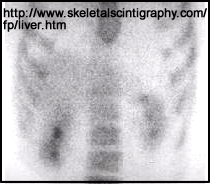- The 99Mo99mTc generator
- 99Mo is the parent that decays to;
- 99mTc the daughter
- The daughter is then extracted for radiopharmaceutical compounding to produce the many types of radiopharmaceuticals used in nuclear medicine
- Usually obtained from a nuclear reactor where Molly is extracted for its medical use
- The idea is to produce a short-lived daughter from a longer-lived parent
- 99Mo T1/2 = 66 hours
- 99mTc T1/2 - 6.02 hours
- While 99Mo/99mTc generator is being used as an example, there are other parent/daughter generators that could be used. Can you think of any?
- From the above diagram all the major components of a generator can be noted
- Saline is initially introduced into the system
- The saline passes through the Molly/Aluminum core
- 99mTc is liberated, in a saline solution while 99Mo remaining in the column
- 99mTc then passes through the Alumina and the glass frit (filter) and then out to elution vial
- The elution vial must be negatively pressured in order for the saline to move through the system
- The type of generator being discussed is known as a dry column generator. Consider that once the saline passes through the column the remaining air that passes through dries the column as its pulled through the system. An additional elution vial can be added to further dry the column
- Wet column generated have also been developed
- This system has a saline reservoir built into the unit
- The disadvantage to this type of system is that the water remaining in the column can undergo hydrolysis (converting H2O to H2O2)
- The advantage to dry column is reduced radiation exposure

- Note the above graph
- Over time 99Mo decays to 99mTc
- 99mTc builds up in the Mo/Al column over time
- In less than 24 hours later (four 99mTc half-lives) from the prior elution 99Mo/99mTc reach equilibrium
- Note the buildup of 99mTc over time
- 1 - T1/2 = 50%
- 2 - T1/2 = 75%
- 3 - T1/2 = 87.5%
- 4 - T1/2 = 93.75
- Note the decay of 99Mo
- It's T1/2 is 2.78 days
- In 24 hours 77.9% of 99Mo remains
- Hence according to the graph above 99Mo/99mTc reach equilibrium in less than 24 hours as parent continues to procedure the daughter product. You could also say that 99mTc builds up over time, until they both reach transient equilibrium. Then they both decay at the rate of 99Mo
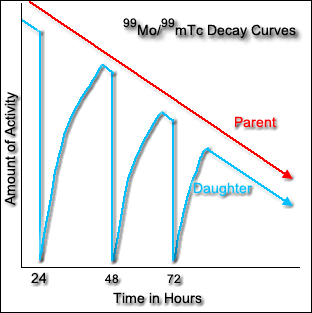
See lecture that applies to this
- Assessing then amount of activity from a 99Mo generator - How much 99mTc will be in your elution?
- Most important is to remember that we are dealing with the decay formula in a modified fashion that helps us determine the activities levels of 99Mo and 99mTc
- Given the formula on the left for both 99Mo and 99mTc the decay factors for one hour can be calculated. The are 0.990 (99Mo) and 0.891 (99m Tc)
- The question determines what the decay factor is from a 3.5 Ci generator at 68 hours post calibration
- The amount of activity that remains after one hour of decay for 99Mo is 1.71 Ci
- Therefore, if the generator has not been eluted in the last 24 hrs, the the maximum yield of 99mTc will be 1.71 Ci
- In reality, the actual yield will be around 85 to 90% of 1.71 Ci
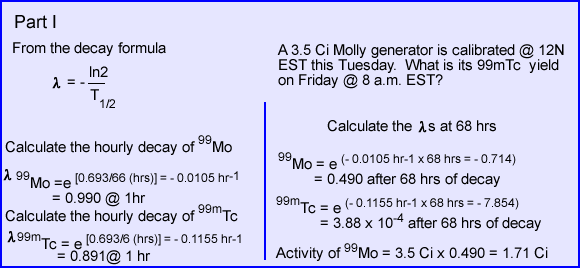
- Transient equilibrium
- This is when the parent T1/2 is not that much longer than that of the daughter
- 99Mo/99mTc is a good example of this
- Secular equilibrium
- This is when the parent T1/2 is much longer than its daughter
- 82Sr/82Rb generator is an example of this
- 82Sr has a 25 day T1/2
- 82Rb has a 75 second T1/2
- As you may recall, this generator is used in PET imaging and is specifically used to image the myocardium
- Elution or eluting the generator occurs when the daughter is extracted from parent. Sometimes this term is referred to as "milking the cow" (I'm not joking)
- Equilibrium occurs when the activity of the daughter matches the activity of the parent
- Other types of generators
- 113Sn/113mIn (115 days and 1.67 hours)
- 81Rb/81mKr (4.7 hours and 13 seconds)
- From the above two generators are they considered transient and/or secular?
- Creating 99Mo from 235U produces yields high specific activity of 99Mo
- Creating 99Mo via neutron irradiation of 98Mo produces a low specific activity 99Mo
- If a 99Mo generate was made from neutron irradiation what might you rationalize when it comes to the density of 99Mo?
- Today 99Mo comes from highly enriched Uranium. In the future low enriched Uranium is the goal.
- Any generator system should have the following properties
- Milking should be fast and convenient
- The daughter should be
- Sterile
- Apyogenic
- pH between 4.5 to 7.5
- Lack impurities
- Contain little to no parent in the elution
- If the next elution occurs at 24 hour then the amount of 99mTc should be between 70 to 90 percent
- What would happen if the generator was eluted 6 hours from its previous elution? How much activity would be in solution if the first elution contained 1000 mCi of 99mTc? (Hint - apply an inverse decay to build up of 99mTc)
- 99Mo breakthrough is measured in a dose calibrator and the procedure is described below
- Measure and record the amount of 99mTc in the elution vial
- Removed the vial from the dose calibrator and
- Set the dose calibrator to measure 99Mo
- Read and record the background measurement
- Place the elution vial into the "special" 99Mo shield
- This is what the above diagram is demonstrating and then placed this into the dose calibrator
- The shield thickness absorbs the 99mTc gammas, however, 99Mo produces numerous higher energy gammas that exit the Molly shield. This is what is being measured
- Subtracting the background reading by the 99Mo reading. This gives you the amount of 99Mo present in the elution
- This value is then applied to the following formula
- Usually there will always be a small amount of 99Mo in the solution of 99mTc
- Consider the effects of 99Mo in the 99mTc solution
- Tagging
- Beta radiation
- Radiation dosimetry to the patient
- FDA requirements
- No more than 0.15 μCi of 99Mo per mCi of 99mTc
- Any dose of 99mTc may never exceed 2.5 μCi of 99Mo
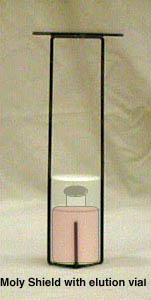

- Remember the Molly core is also composed of aluminum and some may come out with the 99mTc elution
- Too much Al+3 will cause flocculation (precipitate) within the solution
- Al+3 is in colloidal form and if given to a patient would result in liver/spleen uptake
- Al+3 levels should not exceed 10 μg/mL
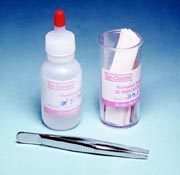
- A procedure test is known as a Colormetric Test which uses litmus paper and a standard solution of Al that has 10 μg/mL
- A drop of elution and a drop of standard are placed on the litmus paper
- If the elution's color matches or exceeds the standard, then too much Al+3 is present and that elution should not be used
- Flocculation has caused liver uptake in a bone scan injection
- Other chemical impurities that are rare, but can be found in fission 99Mo include: 92Nb, 95Nb, 95Zr
